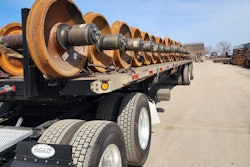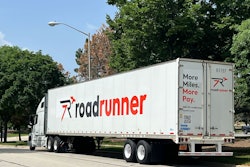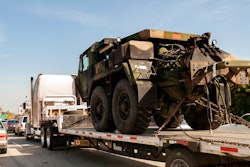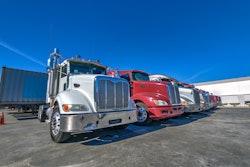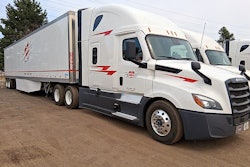Editor’s note: Welcome to the annual CCJ Top 250 ranking of for-hire carriers, the industry’s most comprehensive look at the largest fleets that move freight across North America. What makes our ranking different? Not only do we include revenue in our calculation, but we limit that revenue to freight transportation. Then we track truck and tractor counts as well as the number of independent contractors and company drivers for every carrier and subsidiary within the parent company. The result is a complete picture of each carrier and the overall performance of the industry segment in which they operate. For more details on the CCJ Top 250 ranking and methodology, see 'About the CCJ Top 250' below.
A review of the 2025 CCJ Top 250 ranking of the largest for-hire carriers in North America reveals an industry mired in a years-long slump that has shown few signs of recovery in the near term. On the heels of a horrible performance last year, most trucking companies on the list found themselves in a familiar position: 58.7% of the 2025 CCJ Top 250 fleets that self-reported both 2024 and 2023 revenues posted declines. The good news, relatively speaking, is those companies gave back just 0.64% of revenue year-over-year ($277.4 billion in 2024 vs. $279.2 billion in 2023). Trucking seems to have found the bottom of its trough.
Comparing the 2024 revenue performance of those same companies against the end of a banner run in 2022 that seems like a distant memory, the picture gets much uglier: For the same group self-reporting revenues in both 2024 and 2022, revenues were down 7.8% year-over-year.
See the full 2025 CCJ Top 250 list here
Now well into 2025, trucking is in desperate need of a win. As Werner Enterprises CEO Derek Leathers said earlier this month at the WEX OTR Summit, “It’s been very tough being a trucker,” adding that the current freight downturn has been “the worst in modern history.” But a look back through the annals of CCJ Top 250 reports in recent years shows that the 2009 downturn eclipsed the post-COVID falloff, when in just one year the 2010 CCJ Top 250 revenues fell more than 18%.
In other respects, Leathers’ comment is perfectly valid. The industry has never experienced such a protracted downturn. The current slump is now more than three years old. Most periods of decline since industry deregulation in the early 1980s rarely lasted more than a year before an inevitable rebound.
Few bright spots in a dreary market
Of the nine industry segments in the CCJ Top 250 that make up carrier primary operations, only three groups turned in revenue gains year-over-year. Carriers in the dedicated contract carriage segment turned in the best results as a group with a 6.17% revenue increase, led by a 16.3% increase by Ryder. Tank/bulk and motor vehicle segments turned in more modest gains at 2.23% and 1.01%, respectively.
On the negative side of the ledger, none was worse than the intermodal segment, which posted a 6.48% revenue decline, followed by the usually steady refrigerated segment that posted a 5.29% loss. The remaining segments – flatbed/specialized/heavy haul, general freight, household goods, and package/delivery – turned in more modest losses.
Out of balance
Excluding package giants FedEx and UPS that combine for nearly 275,000 power units, this year’s CCJ Top 250 fleets are powered by 431,382 tractors, 20,396 straight trucks, and 479,233 drivers. Of the 241 other trucking companies that appeared in both this year’s and last year’s ranking, carriers actually increased capacity by 2.07% year-over-year, despite stagnant revenue performance.
A year-over-year comparison of driver counts paints a completely different picture, and one that may more accurately reflect actual utilization and overcapacity in the industry. Those same 241 trucking companies shed 16,343 drivers this year compared to 2024, a 3.32% decrease overall (476,535 in 2025 vs. 492,878 in 2024).
Getting together
The merger and acquisition market has been relatively quiet in the 12 months since last year’s CCJ Top 250 report was published, but a few key deals involving ranked fleets still made an impact on this year’s list.
Schneider National acquired Cowan Systems (formerly No. 54) in a $390 million deal last November, solidifying the Green Bay, Wis.-based carrier’s spot at No. 6 in this year’s ranking and bolstering the company’s dedicated contract carriage business.
Pitt Ohio Express (No. 43) jumped two spots in this year’s ranking with the January 2025 acquisition of less-than-truckload specialist Sutton Transport (formerly No. 204). The company plans to merge Sutton’s operations with subsidiary Dohrn Transfer.
Canadian tanker company Trimac Transportation (No. 64) has been on a tear of acquisitions in the last 12 months, adding Winnipeg-based Searcy Trucking and flatbed company Watt & Stewart. Even though the company’s October acquisition of Service Transport (No. 210) was announced after the 2025 CCJ Top 250 ranking was compiled, it is still worth noting in this year’s list as the addition of 290 tractors and more than 300 drivers will likely move Trimac up the list in next year’s ranking to be one of the top three tank/bulk carriers in North America.
Of course, no annual list is complete without mentioning some sizable exits from the market. Most notably, car hauler Jack Cooper Transport (formerly No. 75) went out of business in February after losing a couple of key automotive OEM accounts. Last year, the company operated more than 1,100 power units with 1,172 drivers.
In July, Carroll Fulmer Logistics (formerly No. 185) announced it was ceasing operations, citing a number of frivolous personal injury lawsuits as a factor in its decision to close.
Also, shortly after last year’s CCJ Top 250 ranking was compiled in September, Robinson, Ill.-based Midwest Transport (formerly No. 179) abruptly went out of business. The mail contractor for the U.S. Postal Service had 440 power units and 464 drivers when it closed its doors.
About the CCJ Top 250
Commercial Carrier Journal has ranked the top for-hire trucking companies since the late 1960s. The CCJ Top 250 is the most comprehensive ranking of active carriers. Our ranking considers not only the revenues posted by a trucking company but also its fleet size and employment base.
Rankings based strictly on revenues often capture activities that have only an indirect relationship to transportation. Blending revenue, equipment, and drivers also allows for a reasonable way to capture carriers that decline to disclose revenue.
The CCJ Top 250 ranking treats all carriers under one umbrella as a single entity. Carriers with significant ownership by an individual, family, or company but not organized under a single management team are treated separately. Also, carriers that went out of business or were acquired by other companies in 2024 and 2025 aren’t listed. Instead, only active carriers are displayed. For a detailed explanation of the CCJ Top 250 ranking methodology, see “Ranking Methodology” below.
The CCJ Top 250 begins with data provided by CCJ parent company Fusable’s RigDig based on data supplied by carriers to the Federal Motor Carrier Safety Administration on their required Form MCS-150 filings. Because this data can be – although rarely is – as much as a couple of years old, and because the MCS-150 does not include information on revenues, all carriers included in the ranking were given an opportunity to review FMCSA data for freshness and to supply information not included on the form. In some cases, CCJ supplements its data with other official sources, such as reports filed with the U.S. Securities and Exchange Commission.
If a carrier declines to verify or update the data that we provide it for review, we presume the publicly available data is valid and use it for ranking purposes. Carriers are not allowed to opt out of the ranking.
Ranking methodology
CCJ’s ranking of companies is a blended scale based on a combination of revenue, total power units, and the number of drivers rather than a ranking simply by revenue. Companies considered for inclusion in the CCJ Top 250 were ranked from high to low by revenue, power units (weighted based on the type of power unit as discussed below), and drivers and assigned a rank in each category.
The numerical rank stored in each of the three fields was added together (revenue rank + vehicle rank + driver rank) to provide a rank sum. This sum was then ordered to provide the overall ranking assigned to each carrier, with the lowest sum receiving the highest rank.
A number of carriers failed to report actual 2024 revenue. In order to be included in the blended ranking, they were assigned – for blended ranking purposes only – a calculated revenue figure determined by multiplying the carrier’s total number of power units by the average of the bottom 50% of revenue per power unit performers for the companies in that carrier’s primary segment.
Calculated revenue almost always will differ from actual revenue, of course, but the effect on the blended ranking likely is slight.
The power unit ranking, which represents an investment as much as a physical-count measure of trucking assets, takes into account the difference between tractors and trucks. The assumption is that a for-hire carrier with 1,000 tractors has a greater investment in equipment than one with 1,000 straight trucks. For the purpose of the blended rank only, a truck was weighted at half the value of a tractor.




